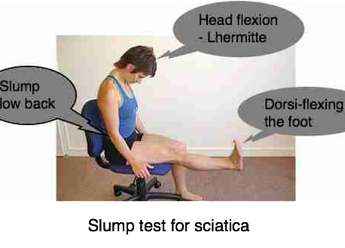Crossed sciatic sign

Crossed sciatic sign can easily be tested at home, preferably with the aid of a helper. It is a passive test so someone else should really lift your leg, but you can cheat and do it yourself if no one is available; it will still give you an indication of what is happening.
The Slump test for sciatica is a complex test and difficult for the lay person, and frankly the expert too sometimes, to interpret. Nevertheless there is a simplified version that will give you some idea of the seriousness of your lower back and leg pain.
Sit in a kitchen chair, and slowly flex your head onto your chest. If that hurts in the lower back or leg it is very significant; it is a sign of meningism.
Now ask your aide to raise your lower leg parallel to the ground; first the leg on the side of pain, lower it, and then repeat with the opposite limb.
In many people there is normal tightness behind the leg; that should be more or less the same in both legs.
If there is no pain in the lower back or leg, be pleased. Now ask your aide to put more stretch on the sciatic nerve by repeating the test, but also dorsiflexing the foot; placing his hand under your foot and pushing the toes towards your hip.
More usually you will have pain more on one side of your lower back, but if it is in the centre, or equally on both sides, then it is more difficult to interpret this Slump test for sciatica.
The more common finding
The more common finding when doing this Slump test for sciatica, is that raising the leg on the same side as your lower back and behind your thigh or calf pain is worse.
The deceitful crossed sciatic sign is when raising the leg opposite to your back pain is worse.
And if raising the leg reproduces the tightness and discomfort down the painful opposite limb, then you are in serious trouble.
The crossed sciatic sign should be handled with great care; it is worth a mention at notice board.
I have a love hate relationship with the medial disc in the lumbar spine. They usually respond magically to the chiropractic adjustment; patients one week call me Dr Golden Hands.
But it still takes a full six weeks for the tear in the annulus fibrosis to heal.
When the pain abates by a half after just a few treatments and is nearly gone within a week or ten days, then it could not possibly have been so serious the patient often thinks. The 50 percent rule is forgotten, the exercises neglected and there is a too-swift return to normal life; a relapse is almost inevitable.
A greater percentage of medial discs thus end up under the knife. One week I am Dr Golden Hands, the next Dr Chiropractic cannot fix a slipped disc, see? You just wasted your time and money.
So, what is that crossed sign? You do the Slump test for sciatica sitting in a normal kitchen chair. Straighten first the leg opposite to the pain; then the leg on the naughty side.
Normally raising the foot on the side of pain is worse; if the straightening the opposite leg is worse, then beware. You have a medial disc; they are extremely deceitful.
For more information, type Slump test for sciatica into the Site Search.
Crossed sciatic sign
And when raising the limb on the less painful side causes pain to radiate not just on the opposite side of your back, but also down the other leg, then you are on the verge of a catastrophe; it is called the crossed sciatic sign.
You must obey your chiropractor's rules to the letter, even if the pain if much improved after a week. This is one of the most serious conditions we treat and some would say you must just go straight to the surgeon; but this is not so.
An x-ray is mandatory and a scan highly recommended despite the cost.
Useful links
Did you find this page useful? Then perhaps forward it to a suffering friend. Better still, Tweet or Face Book it.
